Recently, people have become increasingly annoyed about AI-generated art, but perhaps it is being viewed in the wrong way. Many of the disgruntled and angry claim that it is not real art, that it is low effort and merely copies the style of other artists and reuses images. It has been banned from certain fan community groups too: The Guardian reported last week that a Dune subreddit had banned AI-generated art for being ‘low effort’.
In August 2022, an artwork created by Jason Allen using the AI tool Midjourney, titled Théâtre D’opéra Spatial, won first prize in the digital art category at the Colorado State Fair. This has been widely controversial, with people outraged that an AI program could win such a competition. However, the AI program itself did not win anything. It did not enter itself into this competition or add its work to these group pages. That was the work of the artist. AI image generators should be viewed as merely a new artistic tool.
These arguments would also discount traditional art
AI-generated art is also not always ‘low effort’. When describing his process, Jason Allen said “I have created hundreds of images using it, and after many weeks of fine-tuning and curating my [generations], I chose my top three and had them printed on canvas after upscaling with Gigapixel AI.” Describing something as ‘low effort’ is also a rather misguided indicator of how well-regarded art should be, as many artists make work that is not physically laborious, or do not physically make their own work but are the masters behind their concepts. For example, take Damien Hirst or Jeff Koons, who create the concept around the art and what they would like it to look like and be made of, however, they often subcontract others to make the work due to the scale and specialist materials used.
The argument that AI generators just reuse recognizable pictures is also flimsy, as that concept was the foundation of the whole pop art movement. Should Warhol’s ‘Soup Cans’, Lichtenstein’s ‘Mickey Mouse’ and Richard Hamilton’s ‘Marilyn Monroe’ all be disregarded? Copying imagery and style from other artists is the foundation of artistic practice. For example, in the Renaissance, it was common practice for artists’ apprentices to complete unfinished masterpieces that had been started by their mentors. This would allow them to learn and achieve their ultimate goal, which was to effectively copy the style of their mentor.
AI as a tool
If using tools to create ‘art’ means it cannot be deemed real art, then does that strip all photographers of the right to be called artists? They have also used a tool that is ‘low effort’ to capture images of their surroundings instead of laboriously painting a fantastical scene. Some may even argue that this is a more accessible format for creating art for those who are unable to use more traditional methods, for example, due to disability.
There are concerns, particularly from artists who are understandably worried about copyright infringements. This has led many photo licensing services to begin taking AI-generated images down from their site. To tackle this, we need to ensure that every AI image generator is only fed with images where fees have been paid for licensing or ones that are completely royalty-free.

US Tariffs are shifting - will you react or anticipate?
Don’t let policy changes catch you off guard. Stay proactive with real-time data and expert analysis.
By GlobalDataA new way forward with AI
It is and always will be very subjective on what can be considered art. However, we should be viewing new technology within a lens of familiarity instead of as a new hostile alien phenomenon. If we are to evolve and implement new technology harmoniously and intelligently, we need to view it as our tool, which we control, scrutinize, and work with. Perceiving it as a separate entity that is greeted with kneejerk reactionary anger will not foster a good working relationship with new technological tools.








